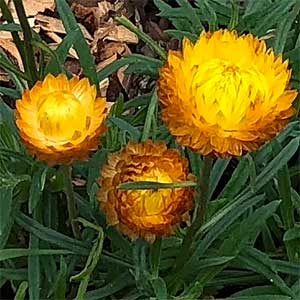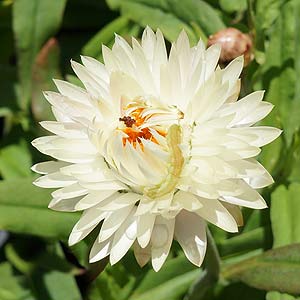
Golden Everlasting
Commonly called the Golden Everlasting, Xerochrysum bracteatum is one of the most widely grown native flowers.
Also known as the Straw Flower and Paper Daisy so common names can be confusing.
With papery flowers that last well when dried, this perennial is a favourite with gardeners and florists alike.
It does vary greatly in form from low growing types to taller plants. The flowers are large and colourful, and with new hybrids available, flower colour is now varied. And just to confuse things a little more, both annual and perennial forms are also available.
These are one of the first Australian plants to be propagated in Europe, and a number of cultivars have been developed outside of Australia. In Europe these are known as ‘straw flowers’ in Australia, ‘Everlasting, or Paper Daisies’ . Flowering time is from spring right through until winter and this long flowering nature makes them a valuable landscaping plant.
These are useful plants for attracting butterfly’s and bees and also makes a good dried flower as well, fairly easy to grow in a well drained soil.
Reasonably drought tolerant and disease resistant, a great Australian plant that is also widely used for cut flowers. The flowers are dried and a are very long lasting.
Xerochrysum bracteatum Varieties
- X. bracteatum Lemon Princess is a yellow flowering cultivar,
- X. bracteatum ‘White Monarch’ is a paper white cultivar. (Pictured Right)
- X. bracteatum ‘Dargan Hill Monarch’, good yellow flowers with a golden centre on a bush that will reach around 1m in height. Way back in 2011 this plant was featured in the Chelsea Garden Show.
- X. bracteatum ‘Diamond Head’ is a low growing variety.

Growing Conditions
Both annual and perennial forms require similar conditions
- A well drained soil is essential, and some extra water during long dry summers is also beneficial.
- An annual application of a slow release native plant fertiliser will improve growth and flower production.
- Plants are best replaced after 4-5 years.
Pruning
Regular pruning seems to improve flowering, it also improves longevity of the plant. Start by removing spent flower heads, it will not only prolong the life of the bush but also encourage a more bushy habit with more flowers. So only a light tidy up after flowers to keep the clumps a little more compact and remove some of the older foliage will be required.
You can also cut newly opened flowers to used in dried arrangements. Cut the flowers with stem, hang upside down in a cool dry position until the flowers dry completely.
Heavy pruning is not recommend as die back often occurs.
Propagation
Two forms are available, those grown an annuals and those grown as perennials. The annuals are grown from seed, the perennials from cuttings or seed.
To grow from seed.
- Sow the seeds into any seed raising mix.
- Keep moist.
- Seeds should germinate in around 2 – 3 weeks
- Keep the strongest seedlings.
- Plant out into larger pots or the garden once the seedlings reach a good size.
Propagation of plants is fairly easy from seeds or cuttings, but remember that cultivars will not come true from seed.
More Australian Native Plants and Flowers
Summary Information
- Botanical Name – Xerochrysum bracteatum. (syn. Bracteantha bracteatum) and previously known as Helichrysum bracteatum.
- Common Name – Strawflower, Golden Everlasting, Paper Daisy.
- Position – Sun to a little shade.
- Soil – Well drained with some moisture during dry summers.
- Height – To around 20cm to 1 metre depending on variety
- Spread – To around .5 metres
- Flowers – Yellow to Pink and Red.
- Flowering Time – Autumn through Winter into Spring
- Foliage – Mid green.
- Frost tolerant – Light frosts only.
- Drought tolerant – Yes
Available for sale from the following nurseries
470 Monbulk-Silvan Road Monbulk VIC 3793
"Guaranteed mail order flowering bulbs, perennials, roses, trees, landscaping plants, garden accessories and community fundraising Austra lia-wide."
www.gardenexpress.com.au
Other Varieties
- Xerochrysum viscosum the ‘ Sticky Everlasting Daisy’
- Xerochrysum bicolor From Tasmania and a threatened species
- Xerochrysum collierianum An Alpine species from Tasmania
- Xerochrysum leucopsideum The satin everlasting from south eastern Australia particularly Victoria
- Xerochrysum palustre This is the swamp everlasting or Swamp Paper Daisy, a threatened species from southern New South Wales to victoriaand Tasmania
- Xerochrysum papillosum From Victoria and Tasmania, an uncommon species but very pretty flowers. One named variety ‘Linda’s Ping is available from specialist nurseries.
- Xerochrysum subundulatum Also known as alpine everlasting or orange everlasting
- Xerochrysum viscosum this is a very attractive species from Victoria especially around alpine areas such as Falls Creek., Tasmania and New South Wales.


